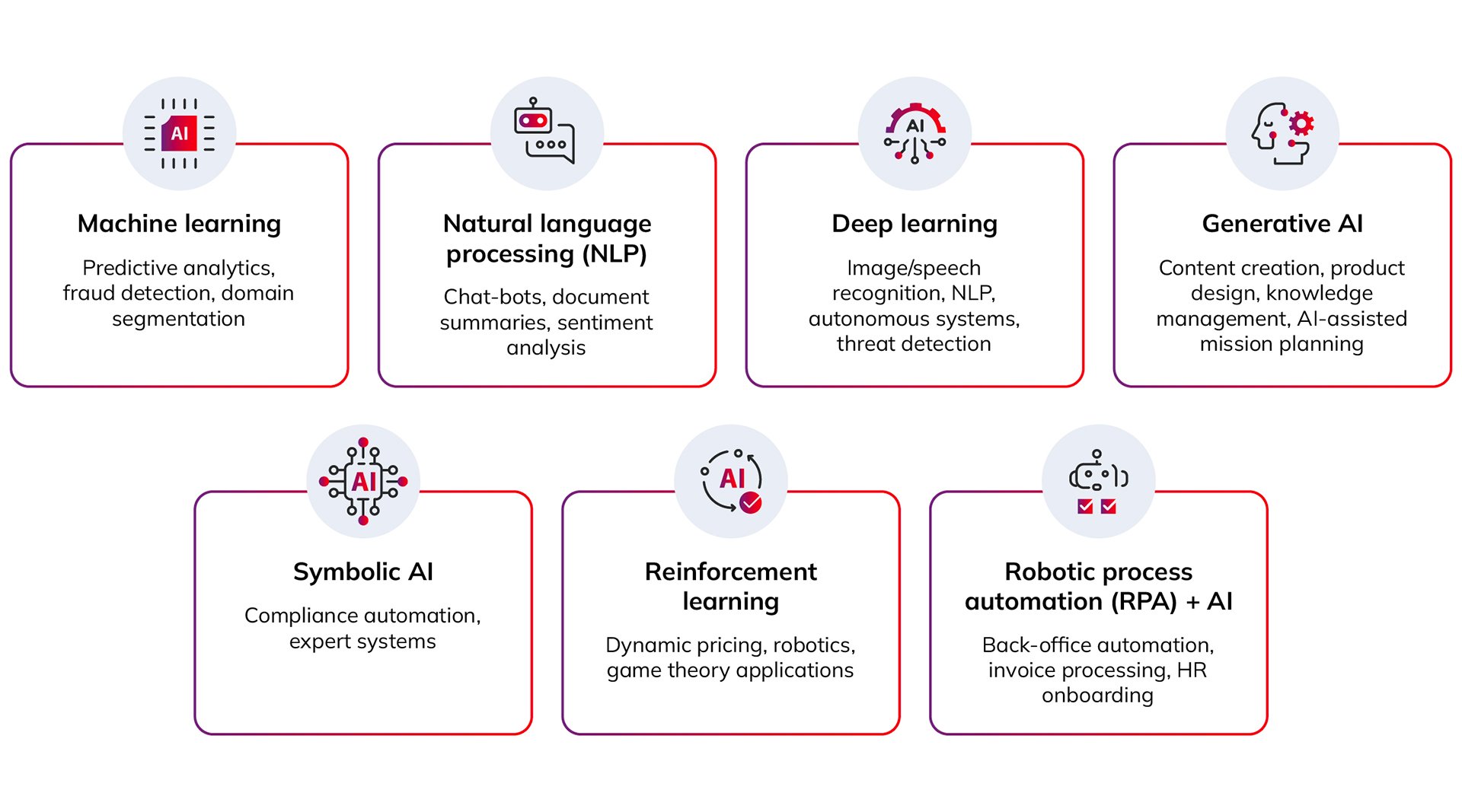Home / Our thinking / Insights / Do different, do better: AI in action for the MOD
Do different, do better: AI in action for the MOD

Table of contents
The United Kingdom Ministry of Defence (MOD) recently kicked off a new series of staff webinars as part of its ‘Do Different, Do Better’ initiative, drawing nearly 150 participants to the first session. Delivered in collaboration with NashTech, the event brought together MOD personnel and technology experts to explore the real-world impact of artificial intelligence within defence. Attendees were challenged to rethink their understanding of AI, as speakers highlighted the ways advanced technologies are already shaping defence support, bolstering national security, and transforming how data is used across the organisation. With a focus on both opportunities and risks, such as supply chain vulnerabilities, the webinar underscored the MOD’s commitment to genuine innovation and unlocking new efficiencies through AI-driven change.
Understanding AI: Origins and evolution
The webinar’s opening session, led by Chris Weston at NashTech, provided an accessible introduction to artificial intelligence (AI), tracing its development and demystifying the technology for MOD staff. AI, as Chris explained, is not a sudden invention but the result of over sixty years of research into how we might simulate human intelligence using computer software. At its core, AI aims to create systems that can learn from experience by exposing computers to large datasets and instructing them with rules, enabling them to make logical, deterministic decisions.
AI is a neural network, like a human brain
Chris highlighted that modern AI relies on neural networks, loosely inspired by biological neurons in the human brain. These networks pass information through interconnected layers of nodes, adjusting the strength of connections based on the data they process. With more computing power and larger datasets, these systems have become capable of recognising increasingly intricate patterns—from identifying objects in images to spotting fraud in financial transactions..
The evolution of generative AI
The conversation then shifted to generative AI (Gen AI) and large language models (LLMs), which have become central to recent developments. These models are trained on colossal volumes of data, sometimes encompassing the entire internet, and excel at predicting the next word in a sequence, creating outputs that often read as if written by a human. However, as Chris stressed, although they appear to “understand” language, LLMs do not possess true intelligence; instead, they excel at statistical pattern-matching, producing convincing text without genuine comprehension.
Fuelling the progress of AI
The rapid progress in AI over the past decade has been fuelled by several key factors:
- Unprecedented computing power: The proliferation of training data as billions of people generate digital content daily, and new hardware such as graphical processing units (GPUs) is becoming widely accessible.
- The arrival of the “transformer” architecture, in particular, enabled LLMs to process and generate vast amounts of text with remarkable fluency. What once required immense financial investment to train an AI model can now be achieved at a fraction of the cost, making advanced AI tools more accessible than ever before.
But, AI is not without limitations
Despite these breakthroughs, Chris was careful to acknowledge the limitations and risks associated with generative AI. Issues such as bias, where models perpetuate prejudices found in their training data, along with hallucinations (the creation of false information), and occasional superficiality in tackling complex or nuanced tasks, remain significant challenges.
The same strengths that enable AI to produce compelling content also create opportunities for misuse, including the generation of misinformation, deepfakes, and increased cybersecurity threats like phishing and data manipulation.
Why this matters for complex organisations like the MOD
- AI can retain and reference far larger volumes of information than any human can, holding data on every single regulation, procedure, piece of historical data, or supplier networks.
- It can detect patterns and identify anomalies across thousands of records or transactions, allowing risks to be flagged before they materialise.
- AI works continuously, 24 hours a day, without forgetting rare or unusual cases from years past.
- It can conduct scenario analysis, running thousands of “what if” simulations in a single afternoon to anticipate potential challenges.
- By automating routine tasks such as searching and administrative work, AI enables people to focus their time on decision-making and applying their judgment.
What’s cutting-edge in AI?
Multimodal models are generative AI tools capable of analysing maintenance records, manuals, photos, and telemetry data to assist with fault diagnosis. These systems can handle complex context, such as determining whether a purchase complies with regulations, by evaluating entire frameworks and considering reasons rather than relying solely on text matching.
AI can also identify inconsistent records, detect duplicate entries, suggest corrections, and contribute to improving data quality. Additionally, edge computing AI models can be deployed on self-contained equipment in constrained environments.
Overall, Chris’ session made clear that while AI’s evolution has been remarkable, driven by technical innovation, exponential data growth, and new computational paradigms, its impact must be understood in context, balancing its transformative potential with a clear-eyed view of its limitations and risks.
Human machine teaming - AI is part of a team
Following a deep dive into the transformative capabilities and limitations of AI for complex organisations such as the MOD, the webinar shifted focus to the practicalities of human-machine collaboration. The next topic explored how AI is shaping the future of support services, highlighting the role of AI as a tool that enhances, rather than replaces, human expertise. The session set the scene for understanding AI not as a replacement for human intelligence, but as a powerful partner in achieving operational objectives.
AI Applicability
Here are some examples of how the AI technologies can be applied to physical and cognitive tasks.

Why AI, why now?
- The world is fast-paced and complex.
- PESTLE factors, geopolitics, supply chains, operations, and resources are all challenging.
- Defence needs efficiency.
- AI enables resilience, agility, and better decisions.
- Technology is integral—AI makes us faster and more precise.
- Allies, competitors, and adversaries use AI.
- We can't afford to fall behind.
- AI offers superior pattern recognition and insights.
- To innovate and be more effective, we need to augment our own capabilities with AI.
AI is beginning to exceed human capabilities, but what can we do now?
Al in support — Short-term examples (within 2 years)
- Policy queries: Connect an AI interface to the Defence Logistics Framework (DLF) so people can just ask questions in plain English and get policy information fast.
- Reporting interface enhancement: Most people want quick answers or to spot anything odd in the Data Warehouse, like checking if rifle part orders match up, rather than doing deep analysis.
- Inventory forecasting improvements: Using machine learning can make forecasts more accurate by picking up on patterns in big datasets, without needing humans to dig through all the data.
Al in support — Mid-term examples (5 to 10 years)
- Predictive maintenance and equipment support: Al and advanced analytics are used to anticipate equipment failures and schedule maintenance actions before breakdowns occur. It enables a move from reactive repair to proactive maintenance, increasing availability and readiness
- Autonomous and robotic logistics: In warehouses and ports, AI-guided robots navigate busy environments, significantly cutting delivery times. This can reduce routine supply tasks and enhance resilience.
- Advanced analytics and decision support: Al-driven analytics aid planning and responsiveness by analysing data to anticipate supply bottlenecks, plan and re-route logistical flows. Real-time dashboards (combining GPS, sensors and data) help answer questions by autonomously checking multiple systems and data sources.
Al in support — Long-term examples (10+ years)
- Fully automated ship re-supply: Using end-to-end supply chain data and digital integrations with industry partners, it can produce plans and and establish potential actions for the automated re-supply pending a Commander to validate and trigger the action.
- Planning most effective material and movement for exercise: Using historical data, strategic models, plans and tactical assessments, ML assesses different scenario options to identify the best balance of efficiency, resilience and timely support presenting them to decision makers to choose.
- Self-optimising logistics: Using real-time data from sensors, and real-time risk assessments of geopolitical risks, weather, cyber threats, transport conditions, changes in tactics, and altered Materiel demands, routes and nodes can be altered whilst outload is occurring.
Key Considerations for AI Adoption and Use
During our webinar, we emphasised that technology—including AI—is primarily adopted to streamline operations and simplify tasks, with improved efficiency being a natural outcome. However, when a new tool like AI is introduced, existing processes need to adapt accordingly; the process must be compatible with the tools it employs.
It’s important to recognise that implementing AI will not automatically fix flawed procedures. In fact, without thoughtful integration, AI can amplify existing problems and even introduce unforeseen challenges. To ensure AI delivers value, it must be continuously refined and improved, which requires consistent feedback and dedicated effort from users and stakeholders.
Active intervention is crucial, especially when AI produces inaccurate or misleading outputs—commonly referred to as 'hallucinations.' If these errors go unchecked, they will persist. Like all digital solutions, AI tools have a lifecycle that demands ongoing management, monitoring, and financial support.
Participants were reminded that AI-generated outputs are inherently imperfect and may vary in accuracy. It is our responsibility to validate the information produced and to ensure we are posing the right questions to these systems. There’s a risk of passively accepting AI results without scrutiny, and, even more concerning, of relying on flawed outputs, which can lead users to adopt incorrect assumptions themselves.
We highlighted the importance of maintaining 'meaningful human control,' human responsibility and accountability for AI-driven decisions and outcomes. This principle ensures that human oversight remains at the centre of AI usage, safeguarding against potential pitfalls and promoting ethical implementation.
In summary, the integration of AI offers substantial benefits such as efficiency, automation, and adaptability in logistics and planning. However, realising these advantages depends on adapting processes, actively managing the lifecycle of AI tools, and maintaining vigilant human oversight. Continuous refinement, validation of outputs, and a commitment to meaningful human control are essential to avoid amplifying existing issues or introducing new risks, ensuring AI acts as a force multiplier rather than a source of complications.
If you would like to learn more about how NashTech can support your organisation’s supply chain and logistics transformation or discuss how AI can be leveraged to optimise your operations, please get in touch with our team. For further information and insights, visit our logistics page on the NashTech website.
Suggested articles

AI for driving customer experience in insurance
Insurance is all about predicting risks and what may happen in the future. Insurance companies are going digital to meet customer’s demands. With the...

All change? The CIO challenge in the next five years
What of the CIO? Ankur Anand, CIO at Nash Squared, looks at how the role of the Chief Information Officer has evolved and where it’s heading in the...
